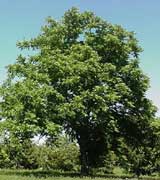


Home
Flowers &
Indoor Plants
Fruits & Nuts
Ornamentals
Vegetables
Special Topics
Resources
Glossary

|
Butternut Juglans cinerea (jug-lans sin-err-ee-ah) 



Click on thumbnails for larger image. |
 |
What about it? The butternut appears to be a well-kept secret; this beautiful tree with the tasty nut is not grown as often as it should be. The nut (or husked fruit) is as large as a pecan, and the shell is quite rough. It is the hardiest of all walnuts. It transplants well and bears at a young age. What is it used for? The meat of the butternut can be eaten by itself or used in baking. The flavor is very distinctive. The wood of the butternut tree is known as white walnut and is favored for its beautiful appearance. Where does it grow? How do we grow it? The butternut will grow in most areas of New York state. It is quite tolerant of poor soils, but like most of the fruit and nut crops, does not perform well in very poorly drained soils. Butternuts become very tall, and must be planted 25-30 feet apart. What are its primary problems? Several diseases, including the Melanconia fungus disease (a canker disease), give the tree a reputation for being short-lived. Leaf spot, bacterial blight and the codling moth are also problems for the butternut. Rats are a problem with nuts on the ground or in storage. The nuts of most butternut trees are hard to crack for satisfactory kernel extraction. All varieties are difficult to propagate. Difficulty in propagation is probably the greatest obstacle to extensive use of butternut selections. How do we harvest and store it? Nuts are picked up by hand soon after they fall from the tree. Remove husks as soon as possible. After you remove the husks and the fruit is dry, store in a dry, airy, animal-proof box or bin. Nuts can be cracked with a hammer or large nutcracker.
© Copyright, Department of Horticulture, Cornell University. |